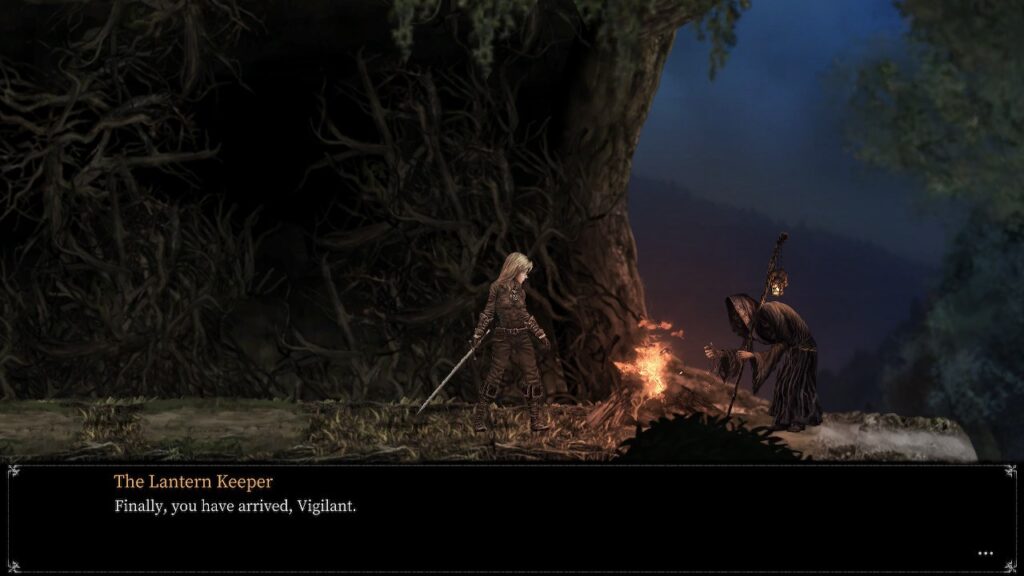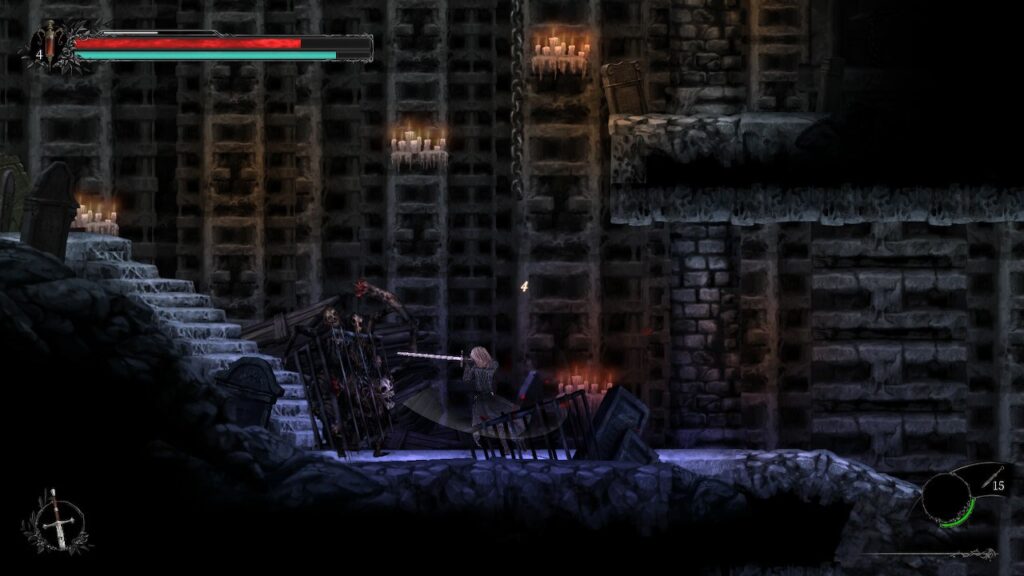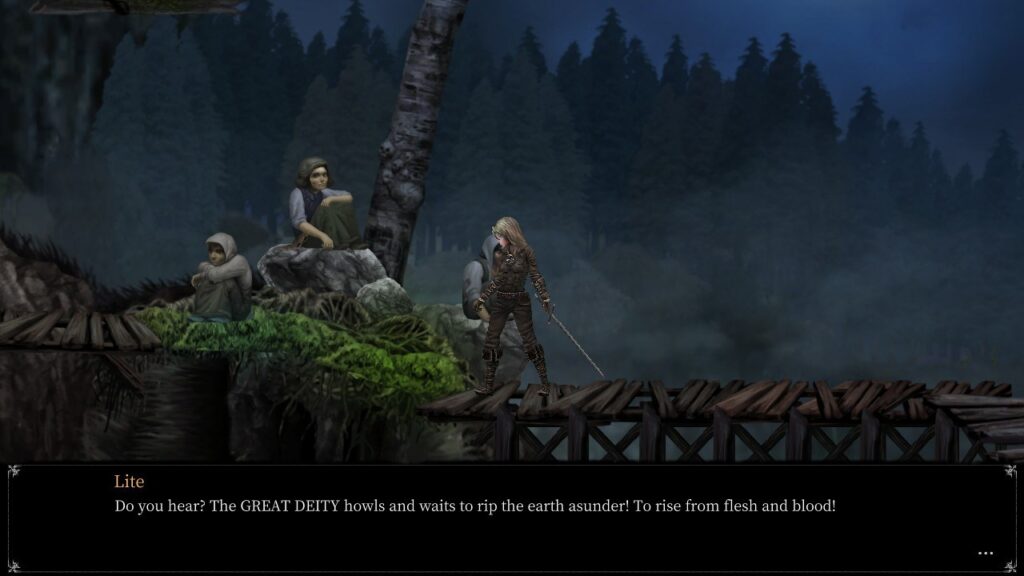
Vigil: The Longest Night is not what you might think. The cover artwork makes the game look soft and compelling, but it’s there to deceive you. Rather, Vigil is vicious, unforgiving, compelling, and spectacular. This new Metroidvania is the first game from Taiwanese studio Glass Heart Games and publisher Another Indie and is anything but your standard fare. Taking its cues from the likes of Dark Souls and Blasphemous, Vigil weaves you into a tale where the gameplay and storyline are equally engrossing, a dark and disturbing fairy tale where you are the last remaining light that stands against the darkness. It’s a clichéd way to say it, but playing Vigil, that’s how you feel.

It’s a compliment to the developers of Vigil that the game is absolutely unnerving. From character designs to background music to animation itself, everything about Vigil is at a bare minimum, vaguely unsettling. Hideous creatures with bizarre appearances lurk in every nook and cranny, gnashing teeth and hurling at you, claws at ready. While this is a 2D game, there’s no question it was inspired by games like Dark Souls, with a difficulty curve that matches the adult content of the game. There’s more than a bit of the feel of Salt & Sanctuary here too, another fantastic game that took its cues from the Souls series. However, Vigil: The Longest Night manages to be so much more than the sum of its parts.

Let’s look at the story first. You play Leila, a “Vigilant” who is a highly regarded warrior, returning to her village from training, only to find her sister and other villagers missing and the town watch virtually impotent. She takes matters into her own hands and Vigil begins in earnest. The depth of character development in Vigil was a surprise and an absolute delight. Sure, the characters don’t say a ton and only change their statements after you progress past key points in the game, but what they do have to say is interesting and well-written. The plot itself is incredibly dark and disturbing and the creatures you encounter as a result are bizarre and unbelievable as well. It would be a shame to ruin the story as its quite good, so suffice it to say that if you give Vigil a fair shake, it will likely surprise you.

Then there’s the gameplay. This is a modified 2D Souls interface with multiple weapon options, buffs, forging and other crafting available, and even a residence that you can use as a home base if you so desire. A vast plethora of items are available to you, including some that have no discernible use. Combat is straightforward, with light and heavy attacks, jumping and blocking, and an incredibly necessary dodge mechanic that’s absolutely required to survive in Vigil. There’s also a fairly significant skill tree that can noticeably upgrade your character’s weapon skills and survival chances. Combat moves a bit slower than one might expect, especially with a stamina bar and a fair number of ranged attack enemies. Instead of darting in and out like most games of this style, you’ll have to go on the defensive, parrying and rolling to avoid attacks and come up behind or even above an enemy, depending on your skill tree selections. Initially, the combat felt clunky, but playing through Vigil, it became apparent that this is an incredibly precise game that requires timing and skill. It’s certainly not a game for the impatient!

As with other games of this style, stamina plays an important role. Squander it and you’re dead in the water, unable to use attacks and forced to go on the offensive. This is a crippling weakness in the wrong circumstances, most notably boss fights where Leila must struggle against near impossible odds to survive. Boss fights are gruelling affairs that hinge on a deep understanding of each of the bosses’ mechanics, something definitely learned and not acquired in a single playthrough. You will most definitely die the first time you fight a boss, and often, several times thereafter. Unlike the regular enemies, boss fights are an extended affair, with many bosses having multiple forms or multiple attacks that force you to maximize your use of special abilities, items, and every trick in the book. The dodge roll mechanic is especially useful here, allowing you to drift through powerful attacks if you manage to time the roll just right. Unfortunately, some bosses are quite fast, and you’ll still have to be on your toes! Don’t expect a walk in the park from Vigil!

Looking at the visual design, Vigil is a masterpiece. Gorgeous backgrounds with high detail levels are everywhere and the game itself has a unique look to the characters as well, part line drawing and part origami, making them stand out from the backdrops in a unique way. Creatures are appallingly disturbing as well, and one must wonder at the mental state of some of the devs to have come up with the myriad of abject horrors featured in the game. The sound matches the unsettling visual style perfectly, offering a powerful soundtrack that dovetails nicely with gameplay both in slower sequences and the faster pacing of boss fights and exciting dramatic sequences. It’s an excellent looking game with an excellent soundtrack, no doubt about it.

Unfortunately, not everything in Vigil: The Longest Night comes up roses. There are some serious technical flaws related to optimization with the game on the Nintendo Switch. The copy provided for use with this review had some significant load time issues. They were so bad that you could time the initial load time of the game in minutes, as in 3-5 minutes to initially load. On top of that, reloading a save took outrageous amounts of time and at one point loading hung for 10 minutes or more, forcing a software restart. The game crashed with a fatal error twice during gameplay for this review, kicking back to the Switch home screen. Even when the game is running smoothly, entering a new area takes a noticeable amount of time to load, one that may irritate many players. These issues severely impact gameplay and seem unnecessary, as this is a game that doesn’t appear to use resources intensely. It’s unclear whether this is a flaw in the port or an optimization issue, but either way, it limits recommendations in favor of Vigil heavily. No one wants to play a game that crashes and won’t load.

Vigil: the Longest Night is a fantastic game with a wealth of creativity, interesting storylines, and outstanding design elements both in the visual and sound departments. Unfortunately, it is utterly bogged down by excessive load times and instability issues that can hopefully be patched in the near future. That being said, the game is amazing and represents a culmination of the platform Souls-style genre that should represent a landmark for years to come in the way that Salt & Sanctuary did before it. At around 18 hours, you’re also looking at a fairly substantial game, especially for $15. This is a game that honestly should not be missed by hardcore platforming aficionados or horror fans, but be forewarned that you’ll be facing some patience-testing issues to play the game. Be wary, but don’t hesitate to check it out!

This review was based on a digital copy of Vigil: The Longest Night provided by the publisher. It was played on a Nintendo Switch in both docked and undocked modes and was outstanding in both!

